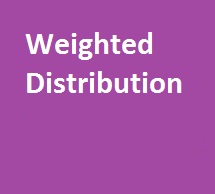ABOUT RETAIL AUDIT


Weighted Distribution is an additional measure of product presence in stores that gives an opportunity to understand the quality of distribution (or distribution efficiency). It is a percentage of stores that sell(stock*) a certain product from the total number of stores, but (unlike Numeric Distribution) taking into account the weight of outlets.
Usually the weight is based on sales volume of the category (Standard Weighted Distribution), however can also be based on the volume of specific segment (Product Group Weighted Distribution) or All Commodity Value (ACV Weighted Distribution).
Standard Weighted Distribution formula:
Weighted distribution = Sales volume of the category in stores which sell(stock*) a product ÷ Total Sales Volume of the category in all stores
*) Stock is relevant for countries with manual Retail Audit only
Example of difference between Numeric and Weighted Distribution:
| Universe | Distribution of Product | Sales of Category |
|---|---|---|
| Store #1 | 1 | 10 |
| Store #2 | 1 | 20 |
| Store #3 | 0 | 10 |
| Store #4 | 0 | 50 |
| Store #5 | 1 | 20 |
| Total | 3 | 110 |
Numeric Distribution = 3÷5 = 60%
Weighted Distribution = (1*10+1*20+0*10+0*50+1*20)÷110 = 50÷110 = 45,5%
You can also calculate a ratio of Weighted and Numeric Distribution, so-called Coefficient of Distribution Efficiency.
Coefficient of Distribution Efficiency = Weighted Distribution ÷ Numeric Distribution
(e.g. in our Example it is 45,5%÷60% = 0,758)
If Weighted Distribution is lower than Numeric, the coefficient is less than 1. In this case we get clear signal of inefficiency and distribution quality can be improved by placing product in “better” stores (stores that sell higher volumes of the Category).
In real life Weighted Distribution is typically higher than Numeric and opposite situation is very rare. So in practice this coefficient is used to compare distribution performance with competitors or to analyze trends. Important point: ratio can be compared only for the products/brands with similar distribution levels, in all other cases the analysis should be done based on sales concentration curve of the category.
Different types of Weighted Distribution:
- Weighted Selling Distribution is Sales Volume of the Category in stores which sell a product divided by Total Sales of the Category in all stores
- Weighted Net Distribution** is Sales Volume of the Category in stores in which product was available at the time of the auditor's visit divide by Total Sales of the Category in all stores
- Weighted Purchasing Distribution** is Sales Volume of the Category in stores that purchased during the reporting period divided by Total Sales of the Category in all stores
- Weighted Handling** is Sales Volume of the Category in stores that sold product during the reporting period and/or it was available at the time of auditor's visit divided by Total Sales of the Category in all stores
- Weighted Out of Stock/OOS** is Sales Volume of the Category in stores that sold product during the reporting period, but at the time of the auditor's visit the product wasn't available in the outlet divided by Total Sales of the Category in all stores. It is calculated as the difference between Weighted Handling and Weighted Net Distribution.
Please note that Weighted Net Distribution (as well as other measures marked with **) is available only in the channels/markets with manual Retail Audit, where outlets are visited by auditors.
Also please take into account that you can’t calculate the ACV Weighted Distribution and Group Weighted Distribution (mentioned above) without help of the agency.